Newton Abbot, Devon
Up to 1834
A workhouse existed Chudleigh from at least 1744 (Hitchcock, 1985). The premises, which adjoined the Plymouth Inn (now the Bishop Lacy pub) on Fore Street, are thought to have dated back to the sixteenth century and prior to 1744 also incorporated the town gaol. The workhouse was rebuilt on the same site in around 1818, with a National School also operating in the new building. The building was sold off in 1838 and is now occupied by the Chudleigh Constitutional Club.
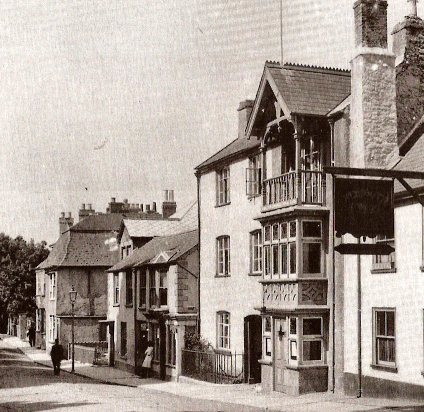
Chudleigh former parish workhouse.
Courtesy of Chudleigh History Group.
A parliamentary report of 1777 recorded parish workhouses in operation at Ashburton (for up to 100 inmates), Chudleigh (20), and Moreton-hampstead (60).
A row of cottages at Ilsington was used as the parish poorhouse until around 1838.
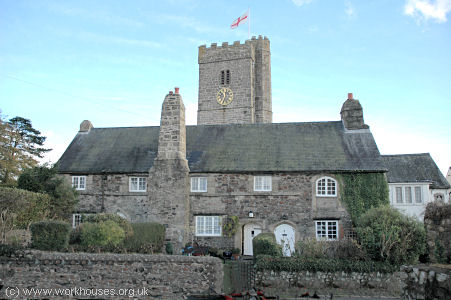
Ilsington former parish workhouse, 2005.
© Peter Higginbotham.
A former church house and sexton's cottage at Widecombe-in-the-Moor was used a the village poorhouse in the early 19th century. The poorhouse occupied the ground floor and the village the upper floor. The building now houses a National Trust shop and village hall.
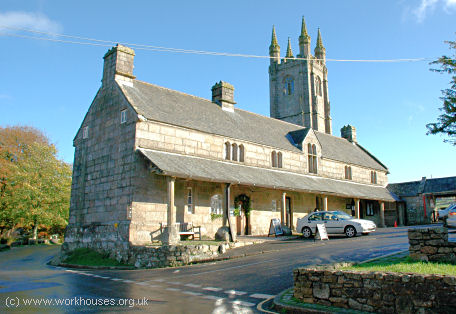
Widecombe former parish workhouse, 2005.
© Peter Higginbotham.
After 1834
Newton Abbot Poor Law Union was formed on 20th June 1836. Its operation was overseen by an elected Board of Guardians, 56 in number, representing its 39 constituent parishes as listed below (figures in brackets indicate numbers of Guardians if more than one):
Devon:
Abbots Kerswell, Ashburton (4), Bickington, Bishop's Teignton, Bovey Tracey (2), Buckland-in-the-Moor, Corkington, Combe-in-Teignhead, Coffinswell, Chudleigh (3), Denbury, Dawlish (3), Haccomb, Broad Hempstone, High Week (2), Hennock, Ilsington, Ipplepen, Ideford, King's Kerswell, King's Teignton, Lustleigh, Moreton Hampstead, Manaton, North Bovey, St Nicholas, East Ogwell, West Ogwell, St Mary Church, Stoke-in-Teignhead, Torbryan, Tor-Moham (3), East Teignmouth, West Teignmouth, Teingrace, Trusham, Woolborough, Woodland, Widecombe-in-the-Moor.
Later additions: Milber (from 1901).
The population falling within the Union at the 1831 census had been 41,180 — ranging from Haccomb (population 13) to Ashburton (4,165). The average annual poor-rate expenditure for the period 1834-36 had been £16,756 or 8s.2d. per head of the population.
The Newton Abbot Union workhouse was built in 1837 at a site on the south side of East Street in Newton Abbot. It was designed by George Gilbert Scott and his partner William Bonython Moffatt who were also the architects for other Devon workhouses at Bideford, Tavistock, and Tiverton. Intended to accommodate 350 inmates, the Poor Law Commissioners authorised the sum of £6,260 on its construction. The workhouse location and layout are shown on the 1904 map below:
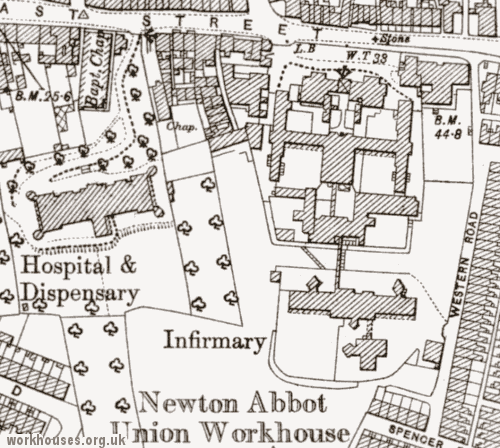
Newton Abbot workhouse site, 1904.
Newton Abbot broadly followed Scott and Moffatt's other designs. At the north of the site, facing onto East Street, was a single-storey front block with a central entrance archway.
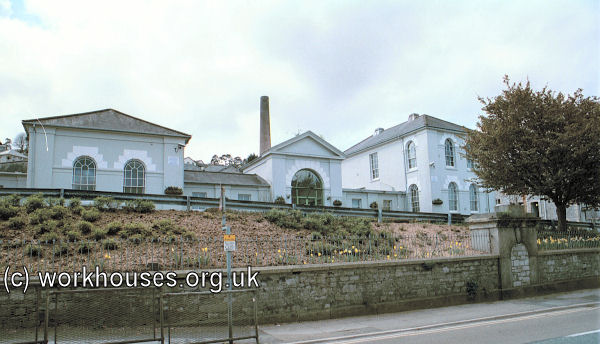
Newton Abbot workhouse entrance block from the north-east, 2001.
© Peter Higginbotham.
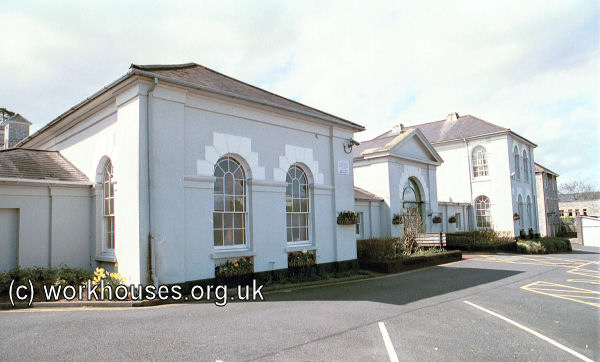
Newton Abbot workhouse entrance block from the north-east, 2001.
© Peter Higginbotham.
An entrance lodge stood to the west of the entrance block.
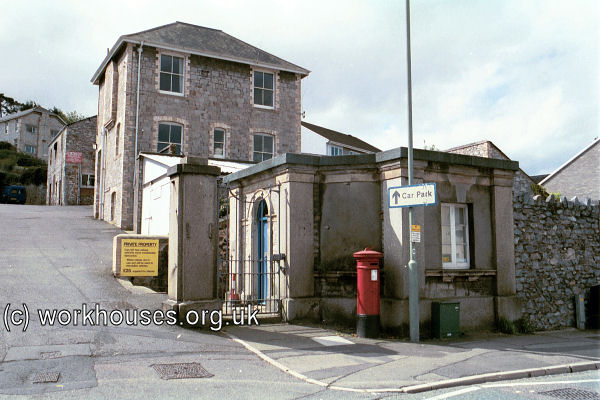
Newton Abbot workhouse lodge from the north-east, 2001.
© Peter Higginbotham.
To the rear of the entrance block was the main accommodation block, most of which was gradually demolished in the 1960-70s. The single storey dining room from the centre rear of the main building survived until 2012, together with two storey blocks to its south which formed part of the original infirmary.
The workhouse was enlarged in 1871, at a cost of £1,600. In 1897, a new infirmary, kitchen, dining hall, laundry, bakehouse, workshops etc. and officers' quarters were added at a cost of £19,000. The new infirmary, situated in an elevated position at the south of the site, accounted for £10,200 of the enlargement costs. It was designed Samuel Segar of Newton Abbot and built by FA Stacey. It was extended in 1911 at a cost of £3,700.
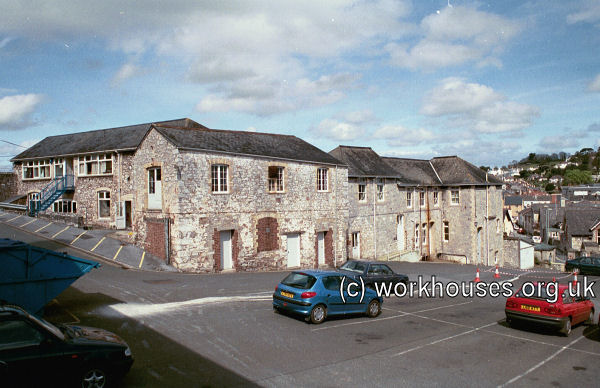
Newton Abbot 1897 buildings at west of site, from the south-east, 2001.
© Peter Higginbotham.
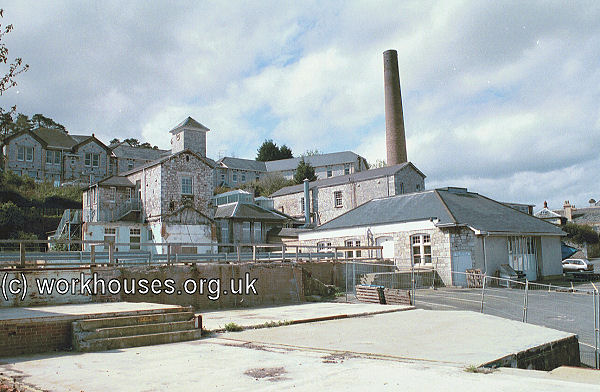
Newton Abbot workhouse dining room (right of centre) and infirmary buildings from the north-east, 2001.
© Peter Higginbotham.
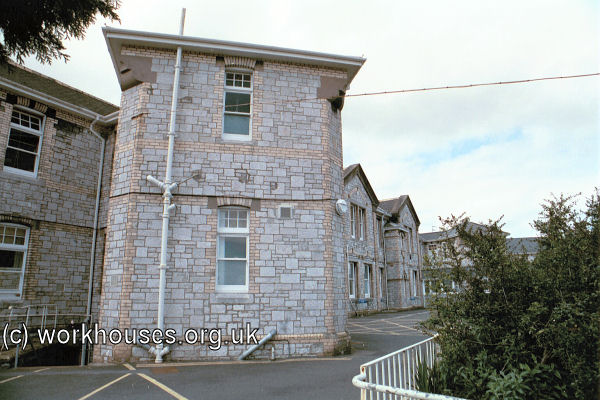
Newton Abbot workhouse infirmary from the east, 2001.
© Peter Higginbotham.
A small mortuary was located to the north-east of the infirmary.
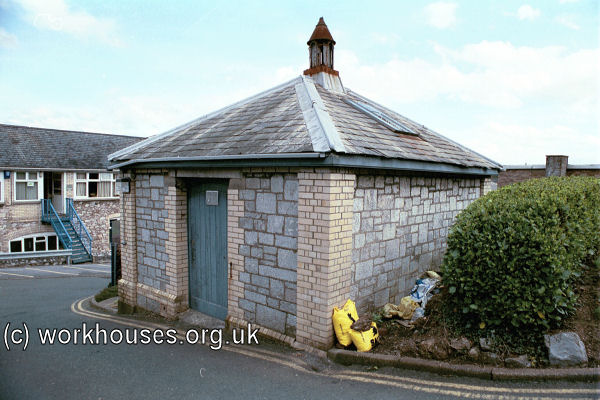
Newton Abbot workhouse mortuary from the south-west, 2001.
© Peter Higginbotham.
As well as administering poor relief, the board of guardians also operated the civil registration system in the union. The register office occupied a building at the north-east of the workhouse, now known as Templer House.
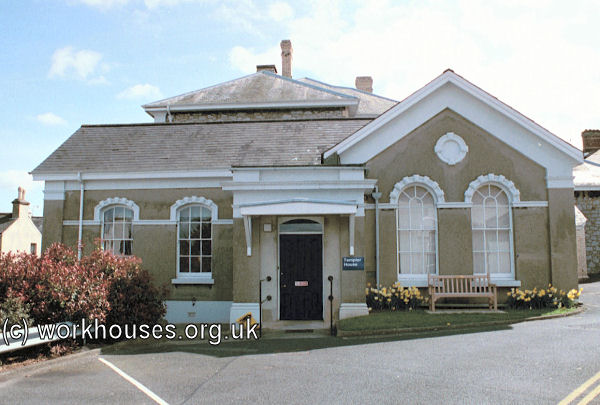
Newton Abbot register office from the west, 2001.
© Peter Higginbotham.
In 1901, the guardians' board room was relocated from the western side workhouse entrance block to new premises adjoining the register office. The new building was also provided with a waiting room for applicants, cloak rooms, lavatories and, on its upper floor, offices, caretaker's room, and nurse and sitting-rooms. The old board-room was then converted into receiving wards and an extra storey added at a cost of about £5,000.
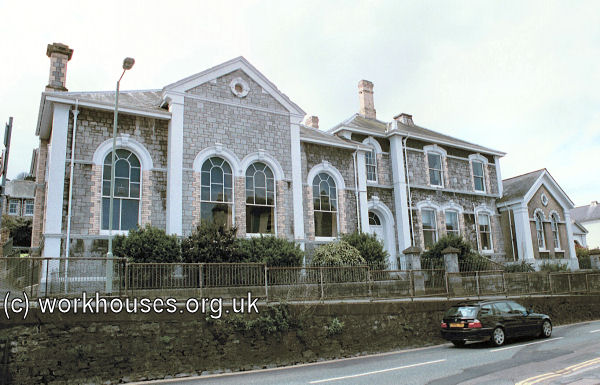
Newton Abbot new board room and offices from the north-east, 2001.
© Peter Higginbotham.
New casual wards were erected at the rear of the entrance lodge in 1903. At the same date, a nurses' home was added at the south-east of the infirmary.
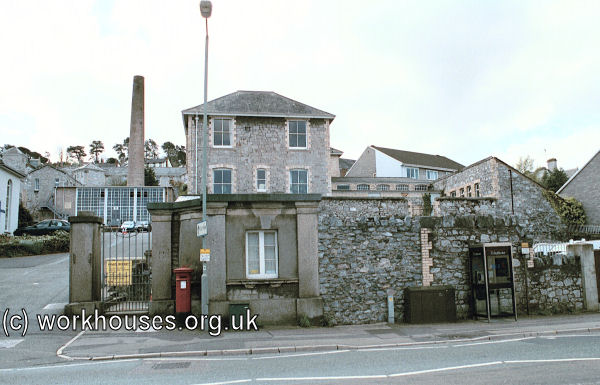
Newton Abbot workhouse lodge from the north, 2001.
© Peter Higginbotham.
In 1906, a new building referred to as a 'nursery etc.' was erected at the east of the site.
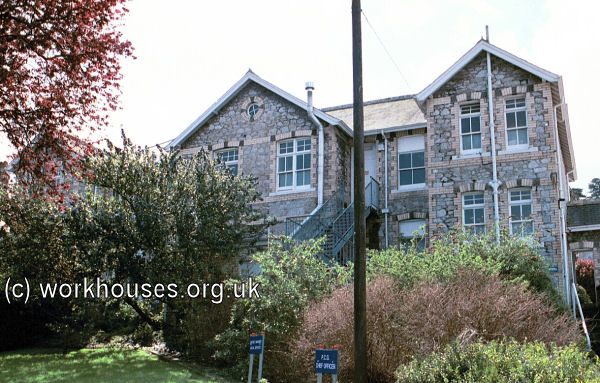
Newton Abbot nursery etc. from the north, 2001.
© Peter Higginbotham.
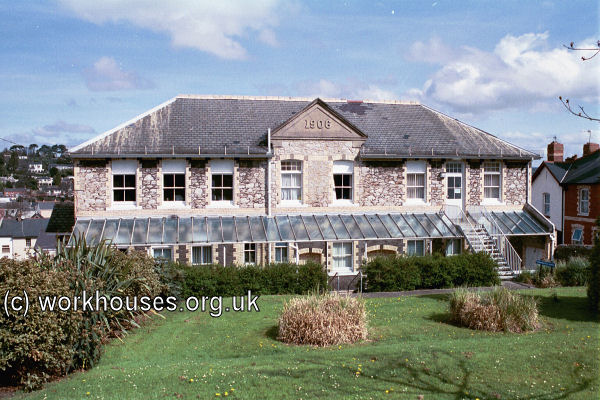
Newton Abbot nursery etc. from the south, 2001.
© Peter Higginbotham.
The workhouse later became Newton Abbot Public Assistance Institution. The buildings subsequently formed part of the Newton Abbot Hospital, which closed in 2009. A number of the old buildings w ere demolished in 2012. The entrance block, infirmary, board room and nursery survive, now converted to other uses.
The Newton Abbot "Jumpers" Scandal
In 1894, the workhouse officers became involved in a scandal which was the subject of an inquiry by the Local Government Board. Witnesses claimed that the "jumper," a sort of sack used as a strait-jacket, was constant use in the workhouse, and that aged inmates had been placed in it naked, and then tied to their bedsteads. A Mrs. Bovey died five days after being confined in the "jumper," and she was said to have been tied down within a few hours of her death. Other witnesses alleged that the wards of the workhouse were in a filthy condition, and many of the inmates infested with vermin. One witness, a nurse named Alice Hinton, testified that she had found an inmate named Mrs. Nicholls apparently dying. The woman was very dirty and covered with vermin. Her hair had been cut off, and her toe-nails were like claws, being 2½in. long. Another woman who was paralyzed had her finger-nails so long that they made wounds in her flesh. In the workhouse yard, Hinton had seen an idiot woman crouched in a corner with her face bruised. The Guardians had built a shed for her in the yard, and witness had noticed that the boys threw stones and snowballs at her. When the master's son was at home he was the ringleader. The boys said that they pelted the old woman to make her swear. It was also alleged that Miss Ann Mance, workhouse matron for almost thirty years, neglected her duties, and had only been seen to visit the sick ward five time over a three month period. to her knowledge. It was further alleged that the fighting among the idiots was especially dreadful on Sunday morning, when the matron was in bed, and Nurse Hinton added that she had also complained to the matron of immorality that was going on amongst the inmates.
Miss Mance gave an emphatic denial to the charges, swearing that she had never bullied an inmate in. her life, and declared that she had exercised proper authority over the establishment. The idiots said to have been cruelly treated had not a single bruise upon their bodies. She had allowed inmates to sing Sankey's hymns on Sunday mornings, but it was utterly untrue to state that the place had been turned into a Bedlam. She never ordered any inmate to be put into the "jumper." "Jumpers" had been introduced by a former nurse, named M'Connell, and they were supposed to be under the control of the nurse. She had never received a complaint respecting their use. In regard to the charges of misconduct among the inmates, the matron declared that it was absolutely impossible that men and women could have been in the laundry together.
Another workhouse nurse, Miss Pike, said she had been given sole charge of about 150 sick paupers in the nursery. The beds were unfit for pigs, and the children were under the care of two partially blind women. One day a child was tied up to the bed with a piece of string to prevent it from running about, as it had no shoes and stockings. Eleven children had only four nightgowns between them. Neither brushes nor combs were provided for the inmates, and their food was kept in the lavatories. A temporary nurse named Elizabeth Wills said she one night found two men tied down in the bed. One was an imbecile and the other was so ill that he died the same day. Mr. John Alsop, union clerk, said the Guardians never ordered the use of jumpers.
Following the inquiry, Miss Mance was dismissed. She died from a heart condition a few weeks later.
Scattered Homes
In the early 1900s, the Newton Abbot Union operated scattered homes for children at a number of locations. In 1914, these were listed as:
- Central Home (boys and girls), Meadowside, 41 Highweek Street (Supt: Alfred RD Digweed; Matron: Mrs Ada M Digweed)
- St Leonard's Home (boys), St Leonard's Road (Foster mother: Miss BH Stab)
- Bradley View (boys), 4 Totnes Road (Foster mother: Miss Esther A Crabtree)
- Greenaway Homes (boys), Highweek Road (Foster Mother: Mrs L Foote)
- Prospect Homes (girls), 25 Prospect Road (Foster mother: Miss EA Edge)
- 27 Prospect Road (Foster mother: Miss AM Driver)
- 75 Wolborough Street (girls, Foster mother: Miss Mary Edge)
In 1919, additional premises were in use at 80 Mount Gold Road. The same homes were still open in 1929 with the exception of the Prospect Road premises. In fact, the references to Prospect Road are possibly incorrect and should be to Prospect Terrace.
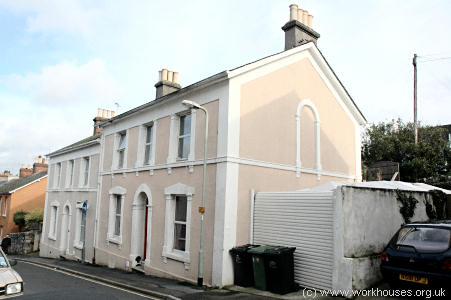
Newton Abbot former scattered homes at 25 and 27 Prospect Terrace, 2005.
© Peter Higginbotham.
The Meadowside site is now used as a Mencap residential home.
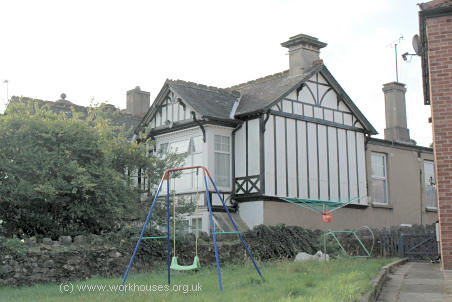
Newton Abbot former Meadowside Central Homes, 2005.
© Peter Higginbotham.
Staff
Inmates
Records
Note: many repositories impose a closure period of up to 100 years for records identifying individuals. Before travelling a long distance, always check that the records you want to consult will be available.
- Devon Heritage Centre, Great Moor House, Bittern Road, Sowton Exeter EX2 7NL. Very few local records survive.
Bibliography
- Hitchcock, T.V. (1985) The English workhouse: a study in institutional poor relief in selected counties. l695-l750. (DPhil thesis. University of Oxford.)
Links
Unless otherwise indicated, this page () is copyright Peter Higginbotham. Contents may not be reproduced without permission.


